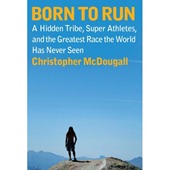how many neurontin for high 
I recently read the book Born to Run by Christoper McDougall. I’ve heard many opinions from fellow ultrarunners the past few months—they either love it or hate it. Most of those who hate it tend to be tied into the shoe industry somehow (hmm, peculiar). All in all, I found the book to be a great (and fast) read.
buy Gabapentin for dogs I also had the privilege to hear the author talk the night before running Iroqouis 100 (now Virgil Crest 100) in NY last month and found him to be interesting, engaging and quite humorous. And, got my book signed with a note that read, “…as Caballo put it, running is magic, man!” Agreed, Chris.
Here’s my take…
Knowing all the ultrarunners he spoke about (Kami, Scott, Jen and Billy)…I found his descriptions of them a bit too “hollywood.” Also, in my opinion, he’s a little unbalanced in his approach, since he refers to running companies as a major cause of our running problems in America. Aren’t consumers to blame too? We do have a choice where we spend our denaros, right?
He also seems to throw around figures and percentages (like 80% of all runners get injured) with nothing really concrete to back it up, which raises a few credibility questions in the reader’s mind. He could have fielded this with some cited studies to back up his figures. Not to say this isn’t true, just seems questionable.
He definitely comes across as anti-shoe and anti-shoe companies. I have to agree with him on a deep, holistic, organic level…people have been getting along fine without shoes for thousands of years. But, I also have to face the facts….us tenderfeets have been locked in shoes our entire natural born lives and we can’t just run out the door barefoot (or even in a minimalist shoe) without getting injured. I’ve tried it.
I would dare say most of us can’t walk around the house for couple of days barefoot without getting some weird aches. A lifetime of shoes have created weak, lazy feet and weak, lazy lower legs.
Side Note: A fun test to see how lazy your feet are—right now—take off your shoes and socks. What? Are you wearing shoes in the house? Ah, man, c’mon, time to break the cycle! Okay, okay, the test: try to spread your toes apart, especially your pinky toe and create space between your toes, then wiggle them. Does smaller toes/pinky toe have ANY range of motion? Not much? Unless you’ve done a lot of yoga recently or like to go around barefoot a lot, your pinky toe may be almost welded to the next toe. (Don’t worry, mine are too!)
Anyway, I completely agree with the author and believe we are “Born to Run.” We should be in minimalist shoes, but this takes a balanced, disciplined approach—especially if you’ve been in orthotics or motion control shoes.
Every runner should mix it up. I totally think barefoot walking/running is great thing to incorporate into training. Start out by walking around barefoot as much as you can. Then try walking around barefoot outside. Then cool down the last 5 minutes of a run barefoot a few times a week. When that feels okay, make it a 10-minute cooldown—and so on. Train shorter, tempo or hill workouts in a minimalist racing flat. I like to play running games with my kids in my Vibram Five Fingers, but don’t go throw down a 2 hour trail run in them—yet. And, don’t stop there. Think about your kids (if you have them). I encourage barefoot play for my kids (no shoes in the house, no shoes outdoors in good weather) and search out a soft, flexible shoe for them so they don’t develop weak feet.
Balance. It’s all about a slow evolution, especially if you want to wean yourself off orthotics or beefy running shoes without injury. So, if you’ve been in shoes your whole life and want to run long and run prosperous, take off those shoes and go for a walk, then a short jog—just don’t throw your running shoes away quite yet. Giddyup!
